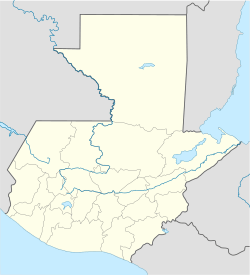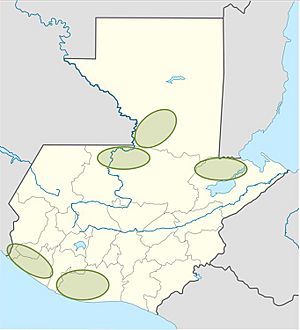El Estor facts for kids
Quick facts for kids
El Estor
|
|
|---|---|
|
Municipality and town
|
|
| Country | |
| Department | Izabal Department |
| Area | |
| • Total | 495 sq mi (1,283 km2) |
| Population
(2018 census)
|
|
| • Total | 73,328 |
| • Density | 148.03/sq mi (57.154/km2) |
| Climate | Af |
El Estor is a town and a municipality located in the Izabal department of Guatemala. It's a vibrant community with a rich history. In 2018, the town had a population of 20,489 people. Most of the people living in El Estor are Qʼeqchiʼ speaking indigenous people.
Contents
Discovering El Estor's Past
Before modern roads and railways, Lake Izabal was a super important link. It connected the region of Alta Verapaz to the rest of the world. What we now call "El Estor" was once a busy spot. It was a place where boats landed and goods were traded. This trading post served towns like Cobán. British merchants, Skinner & Kleé, often called it "the store." Over time, the name likely changed to "El Estor" because of how Spanish speakers pronounced and spelled it.
El Estor officially became a settlement on October 29, 1886. Because it was so far from Livingston, Izabal, President Manuel Lisandro Barillas appointed a special commissioner and a Judge of Peace for the area. A few years later, on November 5, 1890, it became a full municipality. This happened because the distance issue was still a problem.
On January 20, 1940, El Estor was briefly made part of the Alta Verapaz Department by President Jorge Ubico. However, this change was reversed in 1944 after Ubico was no longer president. Then, on June 5, 1945, President Juan José Arévalo officially made El Estor part of Izabal again.
The Northern Transversal Strip
In the 1960s, a region called the Franja Transversal del Norte (FTN) became very important. It was known for raising livestock, valuable wood for export, and amazing archaeological sites. Large international companies, like Murphy Pacific Corporation, invested a lot of money to develop this area. They wanted to settle and use the land in southern Petén and Alta Verapaz.
To help with this, the National Institute for Agrarian Transformation (INTA) started a process. They gave land in the FTN to local farmers. In 1964, INTA officially defined the FTN. It included the northern parts of Huehuetenango, Quiché, Alta Verapaz, and Izabal. That same year, priests from the Maryknoll order and the Order of the Sacred Heart helped move settlers from Huehuetenango to the Ixcán area in Quiché.
The Northern Transversal Strip was officially created by law in 1970. This happened during the government of General Carlos Arana Osorio. The goal was to develop farming in the region. The area included many municipalities across several departments. These were places like San Mateo Ixtatán in Huehuetenango, Chajul in Quiché, Cobán in Alta Verapaz, and the entire department of Izabal.
EXMIBAL Mining Project
During the 1960s, there was talk about letting a Canadian company mine for nickel in Izabal. This idea didn't happen right away. But when General Carlos Arana Osorio became president in 1970, he pushed for the EXMIBAL company to get a mining permit. Many groups in society were against this. They argued it would cost the country too much.
One of the main groups against the plan was a special commission from the University of San Carlos. Important people like lawyer Oscar Adolfo Mijangos López and intellectual Alfonso Bauer Paiz were part of this group. They strongly disagreed with the terms of the mining deal. Sadly, some members of this group faced serious harm because of their opposition.
Finally, on May 8, 1971, President Arana Osorio's government gave EXMIBAL the mining permit. This permit covered 385 square kilometers in the El Estor area. The company invested a huge amount of money, US$228 million, to build the mine. The mining complex was built in the mountains where the indigenous Maya Q'eqchi people lived. It included many homes, offices, a hospital, a shopping center, a school, and even a golf course.
The Panzós Incident
The valley of the Polochic River, also in the Northern Transversal Strip, has been home to K'ekchí and P'okomchi people for a very long time. In the late 1800s, President Justo Rufino Barrios began giving land in this area to German farmers. A law called Decree 170 made it easier to take communal land from indigenous people and sell it. This led to large farms focused on crops like coffee and bananas for export. This system meant that land became owned by a few people, and many farmers worked under difficult conditions.
In 1951, a land reform law was passed to give unused land to farmers. But in 1954, with support from the United States, most of this land was given back to its former owners. Flavio Monzón became mayor and, over twenty years, became one of the biggest landowners in the area. In 1964, many communities living along the Polochic River tried to get official land titles from INTA. However, the land was given to Flavio Monzón instead. Farmers continued to ask INTA to fix land ownership issues throughout the 1970s. They received legal help from a group called FASGUA. But no farmer ever received a full property title. Some got promises, while others only had temporary permits to farm. Farmers began to be forced off their land by landowners, the military, and local officials. This was often to benefit mining companies like EXMIBAL in El Estor.
In 1978, a military patrol was stationed near Panzós. Farmers had become better organized and were actively demanding titles to their land. This worried the landowners. Some landowners, including Flavio Monzón, claimed that peasants wanted to burn down towns to get private property. They asked the Alta Verapaz governor for protection.
On May 29, 1978, farmers from several villages decided to hold a public protest in the main square of Panzós. They wanted to demand land rights and show their unhappiness with the actions of landowners and authorities. Hundreds of men, women, and children, many carrying their farming tools, went to the square. One person who was there said, "The idea was not to fight with anyone, what was required was the clarification of the status of the land. Soldiers came from various places and they had guns."
There are different stories about how the violence started. Some say it began when a peasant leader pushed a soldier. Others say it was because people kept pushing to get into the municipality building, which soldiers saw as an attack. The mayor at the time said that people in the middle of the crowd pushed those in front. A witness said a protester grabbed a soldier's gun but didn't use it. Several people said a military voice yelled, "One, two, three! Fire!" The lieutenant leading the troops then gave the order to open fire on the crowd.
The shooting lasted for about five minutes. Soldiers used their firearms and three machine guns. The square became a scene of great tragedy. Immediately, the army blocked the main roads. An army helicopter flew over the town before picking up wounded soldiers.
El Estor's Economy
African Oil Palm Farming
There's a big need for cooking oils and fats in Guatemala and nearby countries. This is why African oil palm farming has become very common. New companies are investing a lot in this crop, especially in the Northern Transversal Strip. They want Guatemala to become a major exporter of palm oil, even if the international price goes down.
The most active areas for palm oil are Chisec and Cobán in Alta Verapaz Department. Also, Ixcán in Quiché Department and Sayaxché, Petén Department, are important. In these places, a company called Palmas del Ixcán, S.A. (PALIX) operates its own farms and works with other farmers. Another busy area is Fray Bartolomé de las Casas and Chahal in Alta Verapaz. El Estor and Livingston in Izabal Department, and San Luis in Petén, are also active with the Naturaceites company.
El Estor's Landscape
El Estor is one of the most populated rural municipalities in Guatemala. It has over 150 different settlements. The area is known for its diverse natural features.
| Type of Feature | Names |
|---|---|
| Mountains |
|
| Hills |
|
| Mountain Chains |
|
| Valleys |
|
| Rivers |
|
Climate in El Estor
El Estor has a tropical rainforest climate (Köppen climate classification: Af). This means it's generally hot and rainy all year round.
| Climate data for El Estor | |||||||||||||
|---|---|---|---|---|---|---|---|---|---|---|---|---|---|
| Month | Jan | Feb | Mar | Apr | May | Jun | Jul | Aug | Sep | Oct | Nov | Dec | Year |
| Mean daily maximum °C (°F) | 28.3 (82.9) |
29.9 (85.8) |
31.6 (88.9) |
33.1 (91.6) |
33.1 (91.6) |
32.9 (91.2) |
31.7 (89.1) |
32.1 (89.8) |
32.2 (90.0) |
31.1 (88.0) |
29.2 (84.6) |
28.4 (83.1) |
31.1 (88.1) |
| Daily mean °C (°F) | 24.5 (76.1) |
25.2 (77.4) |
26.7 (80.1) |
27.9 (82.2) |
28.4 (83.1) |
28.4 (83.1) |
27.8 (82.0) |
27.8 (82.0) |
27.9 (82.2) |
27.1 (80.8) |
25.5 (77.9) |
24.5 (76.1) |
26.8 (80.3) |
| Mean daily minimum °C (°F) | 20.7 (69.3) |
20.5 (68.9) |
21.8 (71.2) |
22.8 (73.0) |
23.8 (74.8) |
24.0 (75.2) |
23.9 (75.0) |
23.6 (74.5) |
23.6 (74.5) |
23.1 (73.6) |
21.8 (71.2) |
20.7 (69.3) |
22.5 (72.5) |
| Average precipitation mm (inches) | 138 (5.4) |
72 (2.8) |
78 (3.1) |
71 (2.8) |
204 (8.0) |
431 (17.0) |
502 (19.8) |
338 (13.3) |
378 (14.9) |
266 (10.5) |
203 (8.0) |
155 (6.1) |
2,836 (111.7) |
| Source: Climate-Data.org | |||||||||||||
Where is El Estor Located?
This municipality is found on the western side of the Izabal Department. It shares borders with several other departments. These include Alta Verapaz, El Petén, and Zacapa.
 |
San Luis, municipality of Petén Department |  |
||
| Panzós, Senahú, Cahabón and Chahal, municipalities of Alta Verapaz Department | Livingston and Los Amates, municipalities of Izabal Department | |||
| Gualán, Teculután and Zacapa, municipalities of Zacapa Department |
Images for kids
See also
 In Spanish: El Estor para niños
In Spanish: El Estor para niños



